People around the world III
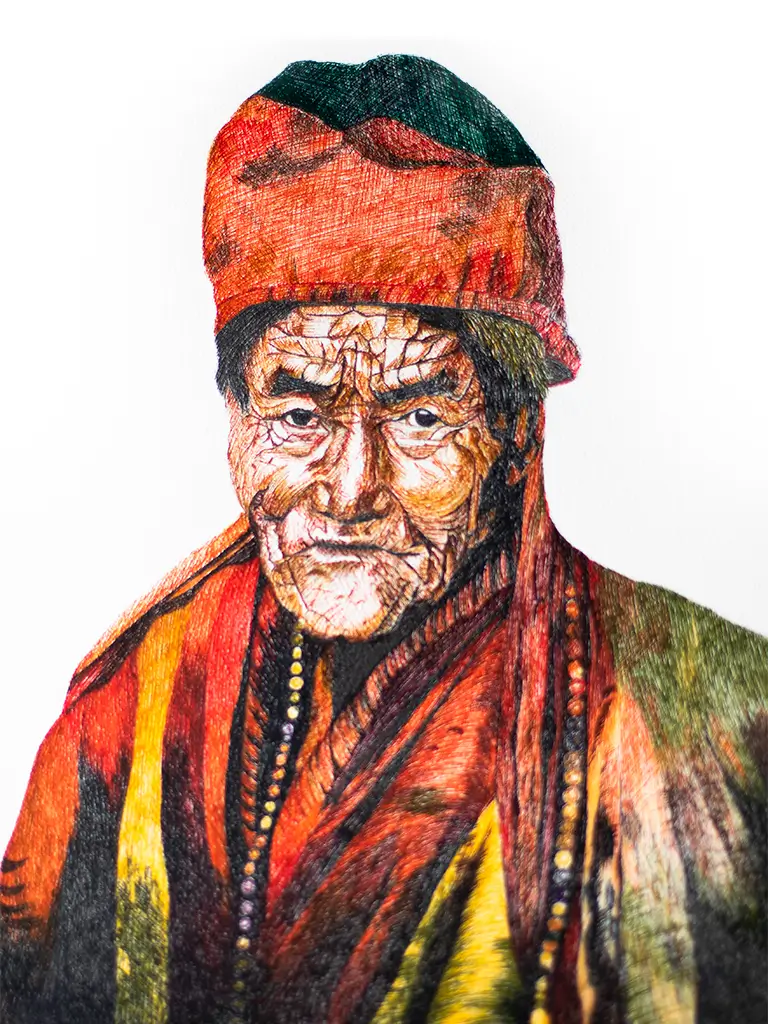
The third portrait in the series shows a woman with a deeply wrinkled face, with the serene dignity of someone who has lived intensely. She wears a voluminous turban and a brightly coloured robe that spills out in rich, expressive folds. A necklace of irregular beads rests on his chest, as if it were just another part of his story. Her appearance suggests South or East Asian roots: India, Thailand, perhaps Mongolia… it doesn’t matter where exactly, but what her face conveys.
The pen stroke, firm and uncorrected, finds in her wrinkles a map of experiences. Each line on the skin is a furrow of time, and each shadow, a story. The colour, vibrant but restrained, gives life to the fabrics, to the brightness of the necklace, to the contrast between the vitality of the outfit and the silent gravity of her expression.
She does not smile or pose. She simply is. She looks straight ahead, with an intensity that does not seek to impose itself, but says it all. Her presence closes the series with a quiet strength, like a root that supports the whole.
Together with the other two portraits – the man with the grey hair and the man in the Arab turban – this figure completes the balance of the series: three faces, three geographies, three different silences, united by the same human gaze.
Pen and colour here become tools of respect, of listening, of attention to the real. It is not a portrait of the exotic, but of the essential.
People around the world II

The second portrait in this series presents the figure of a man wrapped in a light robe and a carefully knotted turban, revealing an identity that evokes the Arab world, at once ancestral and contemporary. His face, serene and silent, seems to look beyond the viewer, as if in dialogue with something we do not see.
The pen firmly traces the lines of expression, the contours of the face, the texture of the canvas. There is no artifice, only the truth contained in each fold, in the way the light rests on the forehead or slides along the edge of the turban. The colours, subtle and measured, accompany the depth of the gesture: ochres, soft earths, touches of bluish shade that envelop the figure in a warm, almost sacred atmosphere.
This portrait, like the other two in the series, does not seek a literal or ethnographic representation. Its strength lies in the gaze, in the restrained attitude, in what is conveyed without words. It is a face that speaks of tradition, of belonging, but also of shared humanity: something that transcends borders and eras.
In the whole, this second painting brings balance and contrast. In contrast to the rebellious hair of the first portrait, here there is withdrawal. Against the questioning gesture of another face, here there is pause. Three faces, three ways of inhabiting the world.
People around the world I
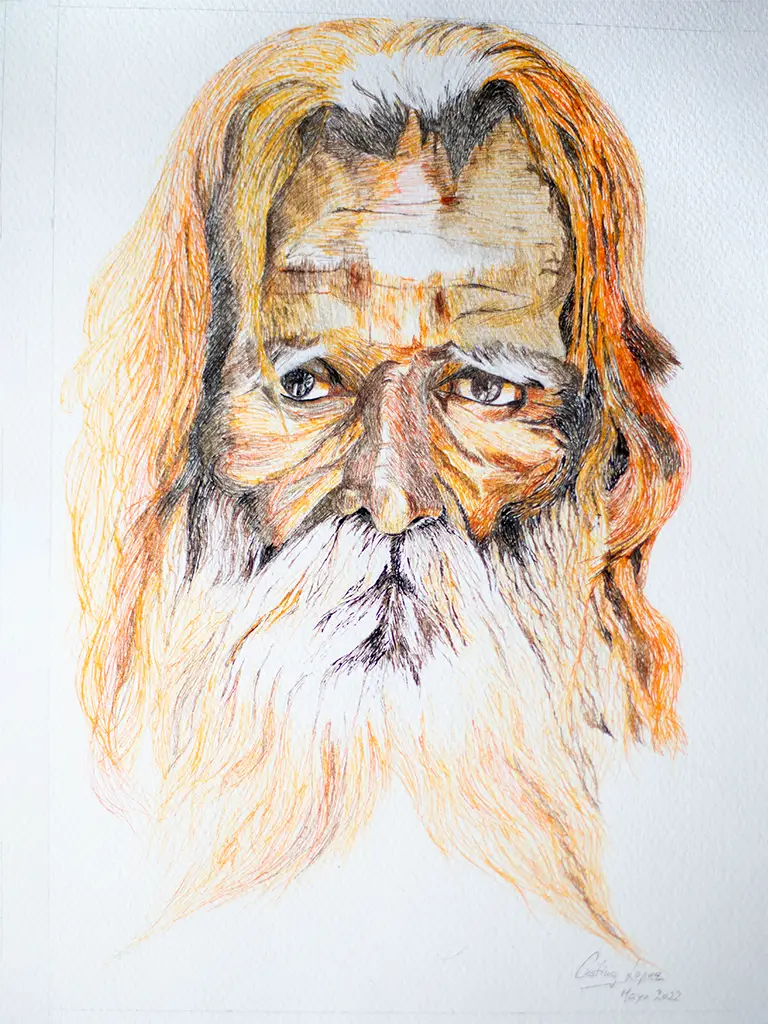
This series of three colour works, executed with biros, is an intimate study of the human in its diversity and depth. Each portrait captures a different face, a particular energy, united by the same technique that combines the immediacy of the pen with the sensitivity of colour applied with restraint and decision.
One of the paintings portrays an Indian man with an intense gaze and abundant, almost wild, grey hair. His hair is not just a physical feature, but a presence, a symbol of identity, of history, of belonging. The pen precisely details the folds of the face, while the colour brings warmth, highlights the contrast between the skin and the hair, and lets the background breathe with a subtly charged atmosphere.
The other two pieces complete the set: different faces, different silences. One perhaps more serene, the other more defiant, but all traversed by the same intention: to capture the invisible. The emotion beneath the surface. The instant suspended between what is seen and what is sensed.
It is not a series about specific characters, but about what they have in common: the imprint of time, the strength of expression, the dignity that emanates from the real. The pen, with its definitive stroke, forces us to look carefully; the colour, with its fragility, reminds us that there is beauty even in the unfinished.
Three paintings. Three faces. A single voice.
Unknown III
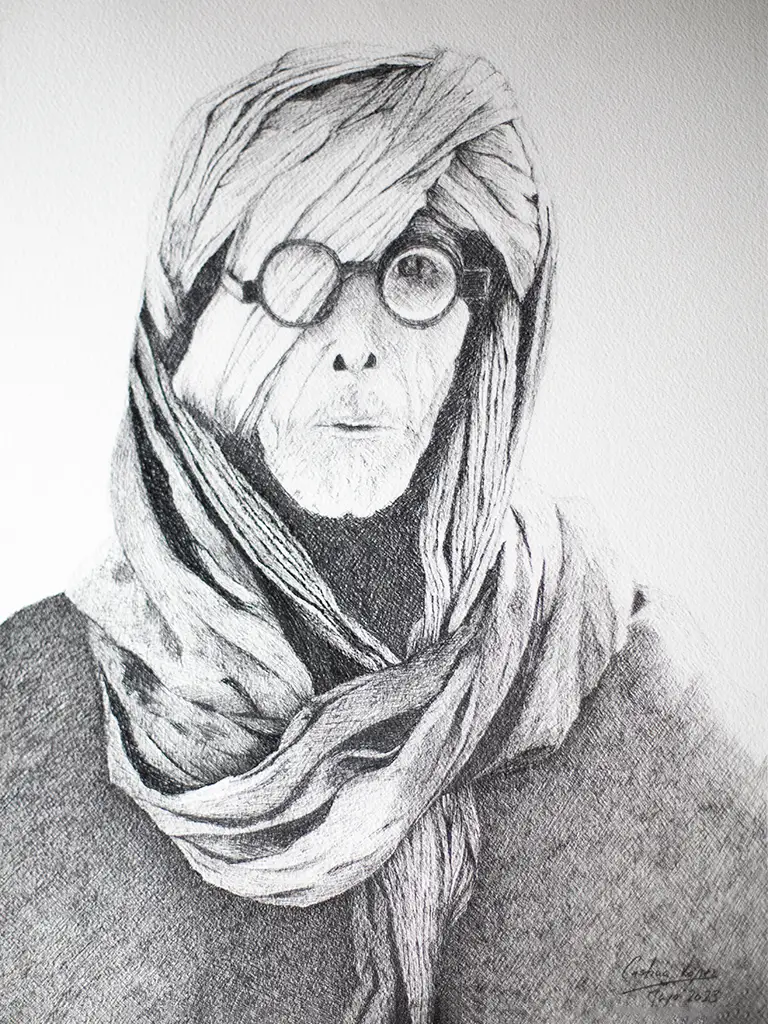
This portrait, painted with marker and pencil – and in some strokes, with biros – depicts the face of an older man wearing glasses and a turban, enveloped in a serene, almost meditative expression. The work, in black and white, renounces colour to focus on the essential: the time inscribed in the folds of the face, the depth of the gaze, the texture of a life.
The technique combines fine lines with areas of shadow constructed from crossed layers. The pen gives a particular density, almost metallic, while the felt-tip pen defines contours and gives weight to the dark areas. The pencil softens, connects, breathes between contrasts. Together, these tools construct not only a figure, but a presence.
The turban, more than an accessory, is a symbol of identity, wisdom and tradition. The glasses frame eyes that look not directly, but inwards, as if they were remembering rather than observing. There is no drama, only dignity.
This drawing is not meant to idealise, but to honour. It is a portrait of humanity, of memory, of roots. Of someone who, although we do not know by name, we feel close to, as if their story – silent, drawn line by line – also spoke a little of our own.
Memories of an afternoon
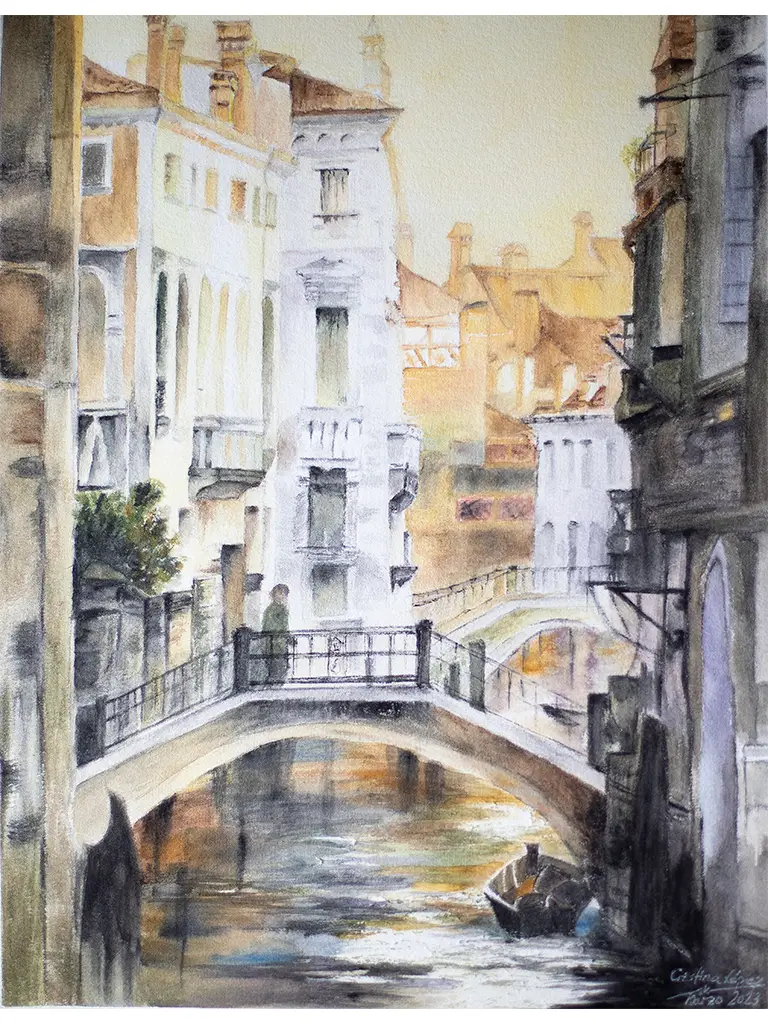
This watercolour painting portrays a European landscape where the river becomes the central thread of the scene, meandering calmly between vegetation-covered banks, small stone houses, and open skies that seem to breathe. The boats float still, moored or drifting, as if resting after a long journey. Some are empty, others barely outline the silhouette of an oarsman, hinting at a story escaping over the horizon.
The watercolour technique allows the water to paint the water: superimposed transparencies, soft reflections, blurred skies in shades of blue, grey and gold. The landscape is not contained, but suggested; there is more emotion than precision. The humidity of the river, the silence of the air, the patina of time on the facades… everything can be guessed in each brushstroke.
Inspired by river scenes from central and northern Europe, this painting seeks to capture not just a place, but a feeling: the melancholic stillness of riverside villages, where life moves to the slow rhythm of the water. In the background, perhaps there is a church or a mill, barely hinted at, as if emerging from an ancient memory.
It is a painting that does not shout, but whispers. A tribute to the quiet beauty of the everyday and the inevitable flow of time.
Memories of Japan
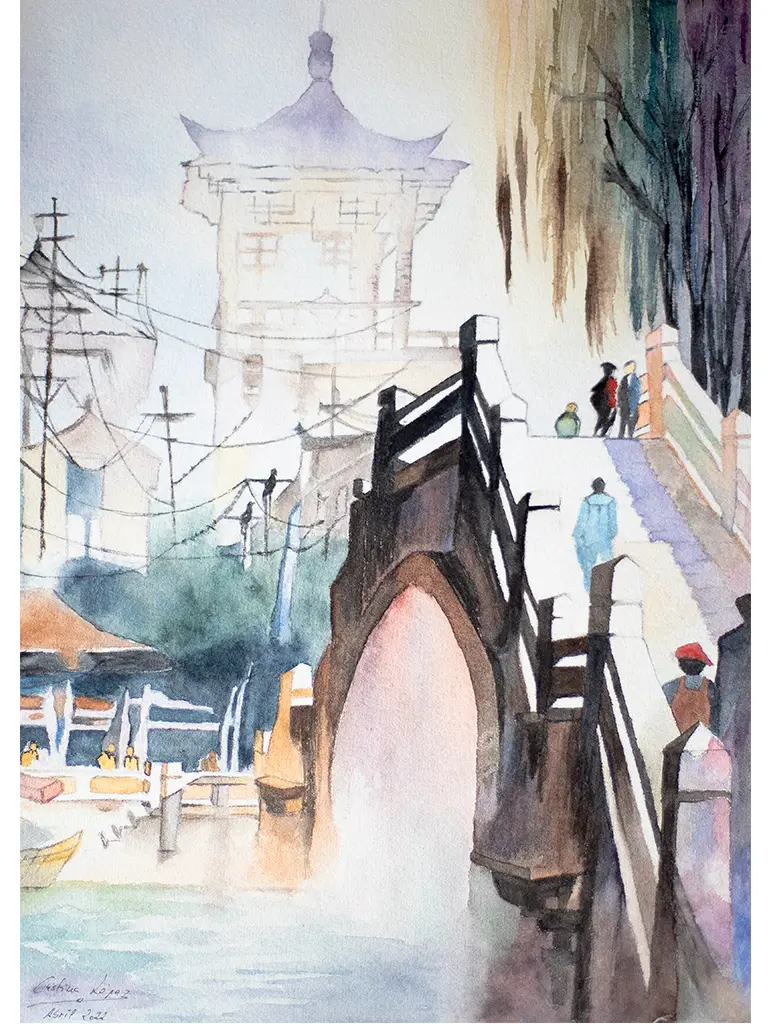
This landscape, painted in colour watercolour, is inspired by the traditional aesthetics of China and Japan, where nature is not only scenery, but spirit. The scene shows a tranquil river flowing through the paper as if it were flowing in a dream. An arched bridge connects the two banks, and on it walk small figures in traditional dress: kimonos or hanfu, serene faces, slow steps. In the background, almost as if emerging from the mist, the curved roof of a temple is insinuated, silently guarding the history of the place.
The watercolour technique has been worked with softness and breath. The brushstrokes are loose but meditated, evoking oriental landscape painting (shanshui) where the important thing is not fidelity to detail, but the balance between full and empty, between what is shown and what is suggested. The water, the silent protagonist, reflects the sky with barely defined spots, while the colours – earthy, soft greens, diluted blues – accompany the calm of the whole.
This drawing is not just an image, but an invitation to meditation. Like the old painted scrolls that were unrolled little by little, this landscape proposes a slow journey, where each element has its place, its weight, its pause.
It is a tribute to the ephemeral, to harmony, and to the beauty that dwells in the simple.
The eye of the horse
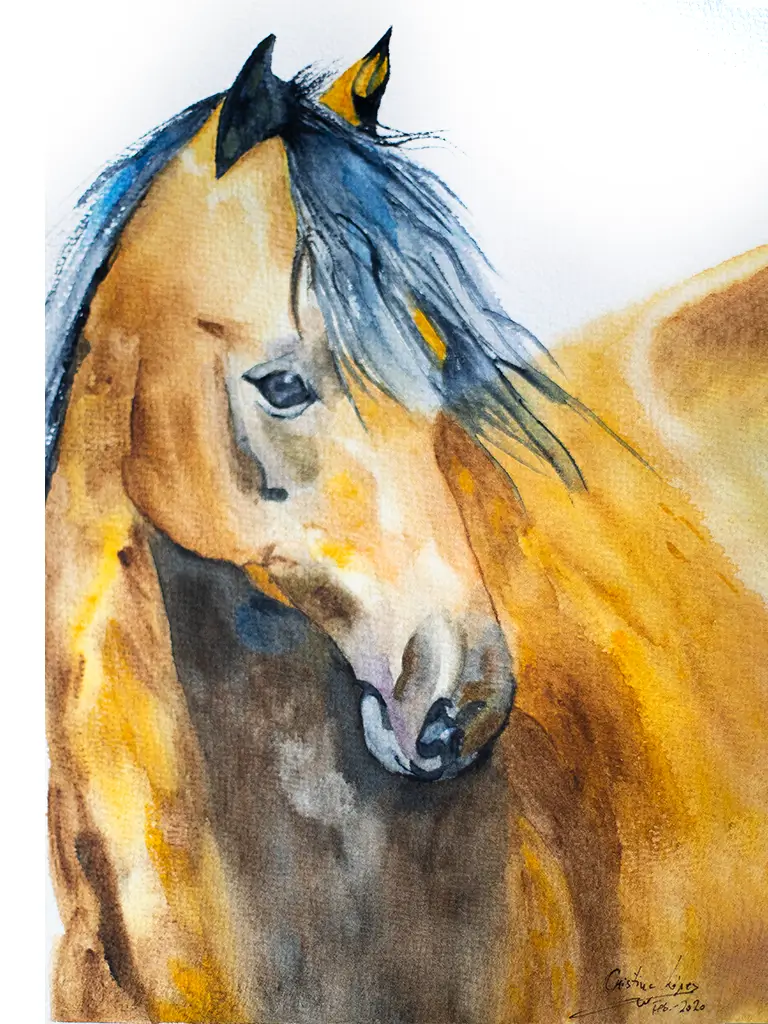
This portrait focuses on the head of a horse, captured in watercolour with a gaze that balances strength with stillness. The choice of watercolour is not accidental: its fluidity allows us to pay homage to the nobility of the animal without enclosing it in rigid lines. The water carries the pigment as the wind caresses the mane – freely, with rhythm, with respect.
Each stroke seeks to suggest rather than define. The soft shadows on the muzzle, the sparkle in the eye, the tufts of hair that blend into the background… everything is worked from transparency, allowing the white of the paper to breathe and give life. It is not a strictly realistic representation, but a presence: that instant when the horse turns its head slightly, hears something in the distance, and everything stops.
This drawing is an invitation to see beyond the form: to connect with the quiet dignity of the animal, with its ancestral memory, its contained power. Because in the silence of its gaze there is something that reminds us of who we were when we still lived close to the land and the animals.